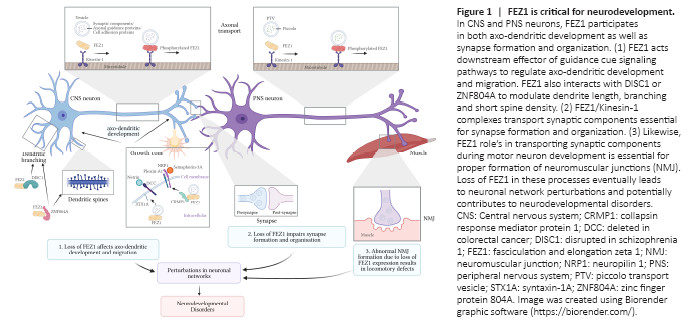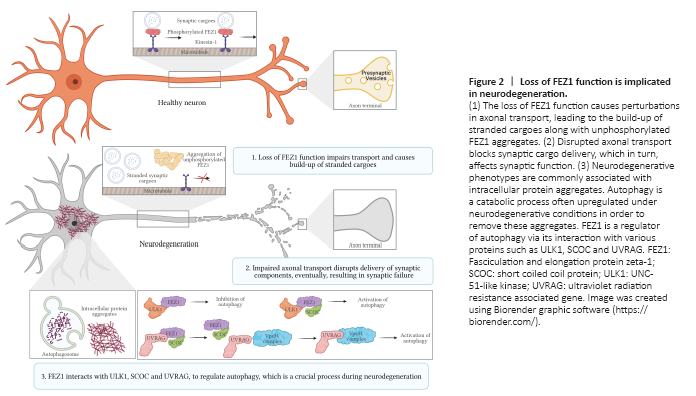神经损伤与修复
-
Figure 1|FEZ1 is critical for neurodevelopment.

The role of mammalian FEZ1 in axo-dendritic development is evolutionarily conserved (Figure 1). Using nerve growth factor-treated PC12 cells as a model for neuritogenesis, expression of FEZ1 temporally coincided with the appearance of neurites in a manner dependent on its phosphorylation by PKCζ as well as ubiquitinylation by the U-box-type ubiquitin ligase E4B (Kuroda et al., 1999; Okumura et al., 2004). More importantly, recent studies employing CRISPR-based strategies further demonstrate that both axon and dendrite development in developing hippocampal neurons are significantly impaired when FEZ1 expression is abrogated (Chua et al., 2021). In particular, total axonal length and the length of the longest axon were significantly shortened in FEZ1-deficient neurons versus control neurons. Axonal branching was also dramatically reduced. Dendrites in FEZ1-deficient neurons showed markedly reduced complexity and lesser branching as compared to control neurons. Motor neurons lacking FEZ1 expression also exhibited similar abnormalities in axo-dendritic development (Gunaseelan et al., 2021). Additionally, total dendrite length was shorter in FEZ1-deficient motor neurons versus control motor neurons. Moreover, neurons in unc-76 mutant worms showed impaired ability to regenerate axons following laser axotomy (Chen et al., 2011). Neurite development defects in cortical neurons knocked down for or expressing zinc finger protein 804A (ZNF804A), a FEZ1-binding protein, appears to be rescued by over-expressing FEZ1 (Dong et al., 2021). Curiously, loss of FEZ1 in an adult hippocampal neurogenesis model reportedly induces over-proliferation of dendrites without impairing axon development (Kang et al., 2011).
Figure 2|Loss of FEZ1 function is implicated in neurodegeneration.

Expression of FEZ1 persists late into adulthood (Whitehouse et al., 2002). While perturbing FEZ1 function early in life is linked to neurodevelopmental disorders, loss of its function at later stages contributes to neurodegenerative disorders (Figure 2). Axonal transport defects in the form of aggregates and synapse loss are observed in neurons missing FEZ1 (Gindhart et al., 2003; Toda et al., 2008; Chua et al., 2012). Moreover, progressive aggregation of FEZ1 is observed in brains of the triple-transgenic mouse model of AD (3xTg-AD). These features are frequently found in neurodegenerative diseases such as Alzheimer’s disease (Bitetto and Di Fonzo, 2020). Importantly, FEZ1 is phosphorylated by microtubule affinity regulating kinases, which also phosphorylate Tau and are implicated in the formation of neurofibrillary tangles and disruption of axonal transport (Butkevich et al., 2016; Combs et al., 2019). Loss of FEZ1 phosphorylation either via substituting the targeted serine with an alanine residue or by using microtubule affinity regulating kinases/PAR-1 mutants also causes axonal transport effects.